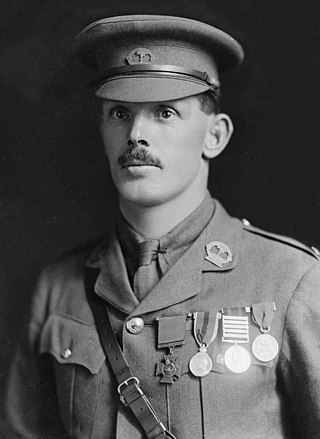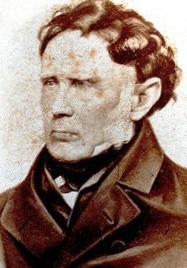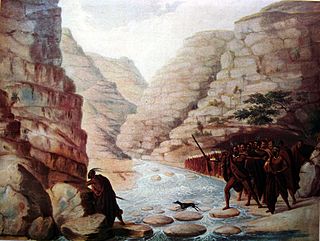This article needs additional citations for verification .(April 2019) |
William Russell Bowker (1855 - 16 July 1916) was an early and prominent South African settler in Kenya.
This article needs additional citations for verification .(April 2019) |
William Russell Bowker (1855 - 16 July 1916) was an early and prominent South African settler in Kenya.
William Russell Bowker was born in 1855 in Grahamstown, Cape Colony. He was the eleventh child of Bertram Egerton Bowker, who had migrated from Northumberland, England to South Africa with the 1820 Settlers. [1]
His uncles had fought in the 6th, 7th, and 8th Xhosa Wars, and his father raised and commanded Bowker’s Rovers during the 1877 Xhosa War, with whom William and his brother George served as Troopers, receiving the South Africa Medal (1877).
Bowker served with distinction during the Second Boer War, serving as a Lieutenant in the Border Horse from February 17 - May 20, 1900, and then as a Captain in the Johannesburg Mounted Rifles. [1] His brother George also served as a Lieutenant in the Border Horse in the war.
Bowker first visited the East Africa Protectorate in 1901 and became impressed by the farming and ranching opportunities in the new country. On his return to South Africa, motivated by Sir Charles Eliot's call for settlers, he sold his estates and recruited a group of aspiring farmers keen to settle in the Protectorate. In 1904 he returned to the Protectorate and impressed Eliot with his efforts to encourage settlement. He made an application for land, and was granted a lease for 30,000 acres in the Kedong valley. [1]
In 1907, together with Ewart Grogan and others, he was involved in an altercation with three Kikuyu men in Nairobi. The incident achieved notoriety at the time due to the heavy handedness of Bowker and his accomplices. Despite his protestations of innocence, the government was keen to set an example and arrested him for illegal assembly, later sentencing him to fourteen days imprisonment and a fine of 250 rupees. [2]
During the First World War he organised a group of irregulars and raised a cavalry known as Bowker's Horse which became part of the East African Mounted Rifles. He died from pneumonia whilst on the field on 16 July 1916 and was buried at Mount Margaret in the Kedong valley. [1]

The history of the Cape Colony from 1806 to 1870 spans the period of the history of the Cape Colony during the Cape Frontier Wars, which lasted from 1779 to 1879. The wars were fought between the European colonists and the native Xhosa who, defending their land, fought against European rule.

William James Hardham, VC was a New Zealand soldier who was a recipient of the Victoria Cross, the highest award for gallantry "in the face of the enemy" that could be awarded at the time to military personnel of the British Empire.

Sir Charles Norton Edgcumbe Eliot was a British diplomat, colonial administrator and botanist. He served as Commissioner of British East Africa in 1900–1904. He was British Ambassador to Japan in 1919–1925.

East Africa Protectorate was an area in the African Great Lakes occupying roughly the same terrain as present-day Kenya from the Indian Ocean inland to the border with Uganda in the west. Controlled by Britain in the late 19th century, it grew out of British commercial interests in the area in the 1880s and remained a protectorate until 1920 when it became the Colony of Kenya, save for an independent 16-kilometre-wide (10 mi) coastal strip that became the Kenya Protectorate.

The Chief Langalibalele Rifles is a reserve infantry regiment of the South African Army.

The Buffalo Volunteer Rifles (BVR) is an infantry regiment of the South African Army. As a reserve unit, it has a status roughly equivalent to that of a British Army Reserve or United States Army National Guard unit.

Major General John Macquarie Antill, was a senior Australian Army officer in the New South Wales Mounted Rifles serving in the Second Boer War, and an Australian Army general in the First World War.

Sir Andries Stockenström, 1st Baronet, was lieutenant governor of British Kaffraria from 13 September 1836 to 9 August 1838.
The Cape Colonial Forces (CCF) were the official defence organisation of the Cape Colony in South Africa. Established in 1855, they were taken over by the Union of South Africa in 1910, and disbanded when the Union Defence Forces were formed in 1912.

Major-General Sir Edward Yewd Brabant, was a British military commander in colonial South Africa. He served in the 9th Xhosa War (1877–1878), First Matabele War (1893–1894), and other campaigns. During the Second Boer War (1899–1902), he commanded the Colonial Division in 1900, and the Colonial Defence Force of Cape Colony in 1901.
Victor Marra Newland, was an Australian army officer and politician. He served in the Second Boer War and with the King's African Rifles in the First World War, was decorated for his service in each, and retired with the rank of major. He was formerly a member of the Legislative Council of British East Africa, and in 1933 became the representative for North Adelaide in the South Australian House of Assembly.

The Xhosa Wars were a series of nine wars between the Xhosa Kingdom and the British Empire as well as Trekboers in what is now the Eastern Cape in South Africa. These events were the longest-running military action in the history of European colonialism in Africa.

The 90th Perthshire Light Infantry was a Scottish light infantry regiment of the British Army, raised in 1794. Under the Childers Reforms it amalgamated with the 26th (Cameronian) Regiment of Foot to form the Cameronians in 1881.

Colonel James Henry Bowker, was a South African naturalist, archaeologist and soldier. He was co-author with Roland Trimen of South African Butterflies.

The Colony and Protectorate of Kenya, commonly known as British Kenya or British East Africa, was part of the British Empire in Africa. It was established when the former East Africa Protectorate was transformed into a British Crown colony in 1920. Technically, the "Colony of Kenya" referred to the interior lands, while a 16 km (10 mi) coastal strip, nominally on lease from the Sultan of Zanzibar, was the "Protectorate of Kenya", but the two were controlled as a single administrative unit. The colony came to an end in 1963 when an ethnic Kenyan majority government was elected for the first time and eventually declared independence.
The Indiana Rangers, also known as the Indiana Territorial Mounted Rangers, were a mounted militia formed in 1807 and operated in the early part of the 19th century to defend settlers in Indiana Territory from attacks by Native Americans. The rangers were present at the Battle of Tippecanoe, and served as auxiliaries to the army during the War of 1812. At the peak of their activities they numbered over 400 men.
Lieutenant-Colonel Joseph Henry Banks (1843–1916) was the British Commandant and instructor of the Auckland Militia through whose capacity the first six of the ten contingents of the New Zealand Mounted Rifles were raised and trained for overseas combat in the Boer Wars, becoming the core of the modern New Zealand Army.

Captain Reginald Berkeley Cole was a prominent Anglo-Irish aristocrat, soldier, and white settler in Kenya. He is notable as the founder of the Muthaiga Club in Nairobi.
Brigadier general William Frederick Savery Edwards (1872–1941), commonly referred to as Brigadier-General W. F. S. Edwards, was a decorated British military officer who was appointed by the British Colonial Administration as the first Inspector General of the Uganda Protectorate Police, which later became the Uganda Police, and the simultaneous overall commander of the then British East Africa Police.

The East African Mounted Rifles was a regiment of mounted infantry raised in the British Colony of Kenya for service in the East African Campaign of the First World War. Formed at the start of the war from volunteers, it was entirely white and drawn primarily from Boer settlers and members of the Legion of Frontiersmen. With horses in short supply, some men were mounted on polo ponies or mules.